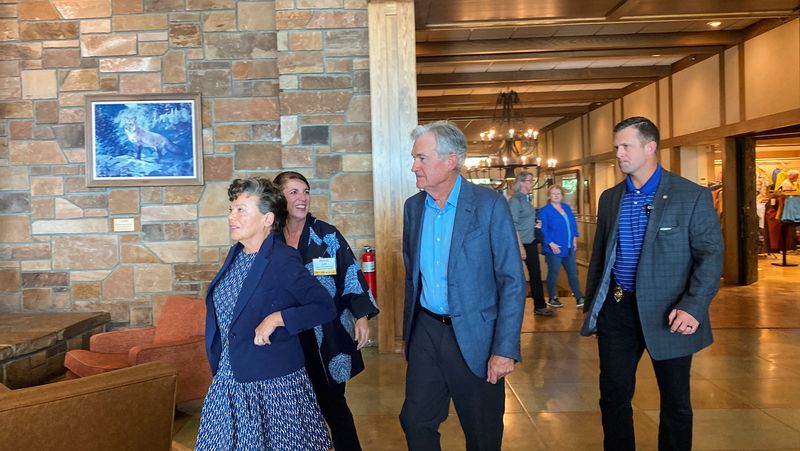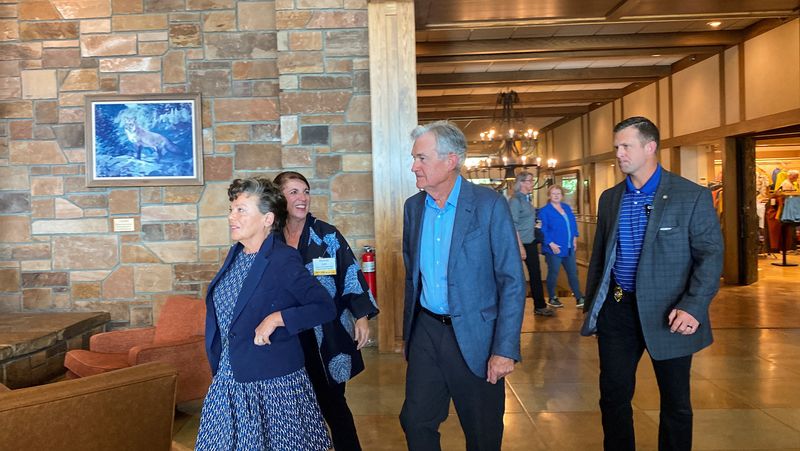Economy
Fed’s Powell says central bank may need to raise interest rates further


© Reuters. Federal Reserve Chair Jerome Powell walks into the opening dinner of the Kansas City Fed’s annual economic symposium in Jackson Hole, Wyoming, U.S., August 24, 2023. REUTERS/Ann Saphir
NEW YORK/LONDON (Reuters) – The U.S. Federal Reserve may need to raise interest rates further to ensure inflation is contained, chair Jerome Powell said on Friday, in remarks that balanced declines in the pace of price increases over the past year with the surprising overperformance of the U.S. economy.
“It is the Fed’s job to bring inflation down to our 2% goal, and we will do so,” Powell said.
MARKET REACTION:
STOCKS: The edged up 0.1%, Nasdaq was flat and the Dow was up 0.4%.
TREASURIES: The U.S. Treasury 2-year yield [US2YT=RR] was up 5 basis points at 5.067%
FOREX: The U.S. dollar was up 0.3%
COMMENTS:
JASON ENGLAND, GLOBAL BONDS PORTFOLIO MANAGER, JANUS HENDERSON INVESTORS, CALIFORNIA
“After a Volkeresque hawkish speech at last year’s Jackson Hole Symposium the tone was less stern this year, but still had a hawkish tilt to it as the job is not done on inflation and it is too early to declare victory.”
“Restrictive monetary policy is needed to achieve progress and it is the Fed’s intent to hold it there until they are confident inflation is moving sustainably down to their 2% target. He also made it clear that 2% is and will remain their target silencing any chatter from economists to increase the target.”
ROSS MAYFIELD, INVESTMENT STRATEGY ANALYST, BAIRD, LOUISVILLE, KENTUCKY
“I thought the speech was hawkish, as Powell reiterated pretty explicitly that they view inflation risk is to the upside, and that they wanted to keep policy restrictive, you know, for a longer period of time to get inflation under control. It wasn’t anything new, but it definitely didn’t signal any easing or thoughts about easing.”
DAVID SADKIN, PRESIDENT, BEL AIR INVESTMENT ADVISORS, CALIFORNIA
“There was a little something for everybody. If you’re a bear, you heard him say we’re going to be restrictive, and we might hike rates and there’s still a lot of work to do. If you’re a bull, you heard him say, we’re making progress against inflation and we still expect there to be a lag in from the effects of monetary policy, and we could be on hold.”
“So people heard what they wanted to hear, but for the most part investors are comfortable, especially after this sell off in August that they’re positioned for not so much for the next couple of months.”
RYAN DETRICK, CHIEF MARKET STRATEGIST, CARSON GROUP, OMAHA
“(Chairman Powell) didn’t appear to rock the boat very much, but did show concern the economy is heating up, potentially opening the door for more hikes or leaving rates higher for longer.”
“That does run counter to the recently released Fed minutes, which discussed a potentially weakening economy. But overall, at last year’s Jackson Hole meeting he surprised by coming off more hawkish than expected. And this year that doesn’t appear to be the case. He kind of hit the ball down the middle of the fairway.”
ROHAN KHANNA, HEAD, EURO RATES STRATEGY, BARCLAYS, LONDON “It’s tough to rationalize the move (in bond markets). The speech is very balanced but clearly points to the risk of doing more rather than doing nothing at all. It’s not about when do we start easing but whether we need to do more. So, the fixed income selloff reflects that.”
MICHAEL ARONE, CHIEF INVESTMENT STRATEGIST, STATE STREET GLOBAL ADVISORS, BOSTON
“Powell continues to walk a tightrope. Unlike last year, where he really wanted to emphasize the Fed’s inflation-fighting credibility, this year I think he is demonstrating that he is pleased with how far monetary policy has come and how inflation has been reduced. But he is still holding on tightly to this notion that they are watching it carefully and they still have work to do.”
“I do think that the market continues to underestimate the potential for at least one if not two more rate hikes should inflation remain above the Fed’s target. Even this morning during the speech, he emphatically said 2% is and will remain our target. And as a result, until we get closer to those levels the Fed is likely more hawkish than dovish.”
BRIAN MULBERRY, CLIENT PORTFOLIO MANAGER, ZACKS INVESTMENT MANAGEMENT, CHICAGO
“Early in Chair Powell’s comments, he has described the difference clearly between short term declines in core PCE and the 12 month change, the longer term price comparisons show that restrictive monetary policy is still needed to bring sustained progress on overall prices. This is already weighing on markets as the slightly hawkish comments are showing that rates are likely to go higher and stay there for longer than markets have currently priced in.”
VIRAJ PATEL, GLOBAL MACRO STRATEGIST, VANDA RESEARCH, LONDON
“The fact that he said policy is well above most neutral estimates is not what the bond market has been pricing in recent weeks. So that’s a disappointment for bond bears. He kept absolutely every possible option on the table by saying nothing new.”
JUAN PEREZ, DIRECTOR OF TRADING, MONEX, WASHINGTON
“Markets are being provided little in terms of clear guidance because not even Fed officials can see clearly what difficulties may arise in the future.”
“In the midst of an expanding American economy, Powell has to say that all moves will be very data-dependent, and he seems to feel no need to guarantee any pauses. The Dollar seems to be naturally strengthening, equities may even feel some downward pressure, but I still sense that down the line there will be a decoupling of Dollar-advancement tied to Fed hawkishness. There are signs that borrowing costs have increased to a point of denting demand, especially for Housing, so if anything there are chance the economy may not stay so hot in order to feel the need to hike interest rates again.”
CHRISTOPHER HODGE, CHIEF US ECONOMIST, NATIXIS, NEW YORK
“He was very quick to assure markets that the Fed won’t be hanging any ‘mission accomplished’ banners any time soon, but still highlighted the need to data dependence. Clearly softer labor and economic indicators are needed before any pivot in tone, but just reiterating the higher for longer narrative by itself restricts financial conditions by pushing up mortgage and corp borrowing rates (see the Fed’s FCI-G and movements along the curve in recent weeks) and may alleviate the need for more hikes.”
“It was a change in emphasis, highlighting the potential need for more tightening, but it doesn’t change the fact that softer incoming data will keep the fed comfortable with current levels and allow previous hikes and current conditions to work their way through the system. I think the Fed is legitimately split on what to do now making incoming data, starting with next week’s NFP and JOLTS, even more important.”
MICHAEL GREEN, CHIEF INVESTMENT STRATEGIST, SIMPLIFY ASSET MANAGEMENT
“The best way to think about it is: it was largely non information. It is an acknowledgment of some progress that has been made. It’s a reiteration that the Fed at best is going to go very slowly and cautiously.”
“People had been prepared for volatility if that volatility fails to emerge. Then the big winner here are people who had actually sold insurance in the market. I don’t think anyone’s going to meaningfully change their positions after this speech.”
ANDRE BAKHOS, MANAGING MEMBER, INGENIUM ANALYTICS LLC, PLAINSBORO, NEW JERSEY.
“August has been a difficult month for the market, so it is hungry for news that will help reverse the trend. Investors are hanging on to every word, but the main takeaway is that Powell signalled that the Fed would raise rates if needed. Around that concept, we’re going get intraday volatility.”
CARSTEN BRZESKI, GLOBAL HEAD OF MACRO, ING, FRANKFURT
“The speech was as expected. I don’t think it’s overly dovish as the market reaction suggests. A pause in September is likely but this is not an official end to hikes. This is the best Powell could do in the current circumstances.”
“The alternative would have been to sound very hawkish, triggering turmoil, or sound very dovish, which is not good if inflation comes back, so this strikes a good balance. I think (ECB chief Christine) Lagarde will do the same later.”
JOSEPH LAVORGNA, CHIEF U.S. ECONOMIST, SMBC NIKKO SECURITIES, NEW YORK
“I have him leaning a little bit more on the hawkish side because it seems to me that while they’re talking risk management, I just don’t see anything that suggests that they’re going to cut rates anytime soon.”
“He’s finding the flexibility to hike more, not buying the flexibility necessarily to ease. It seems to me it’s between hiking more and staying on hold rather than, ‘OK we’re kind of where we need to be and policy is symmetrical.’ But, I don’t think another hike is coming.”
STUART COLE, CHIEF MACRO ECONOMIST, EQUITI CAPITAL, LONDON
“Powell’s message is largely as expected, that is progress is being made in the fight against CPI but it is too soon to say the battle is won and the Fed is prepared to hike further if necessary. My hunch is that he is being seen as not as hawkish as had been feared.”
QUINCY KROSBY, CHIEF GLOBAL STRATEGIST, LPL FINANCIAL, CHARLOTTE, NORTH CAROLINA
“He is outlining the backdrop for the path of inflation, the trajectory that we have witnessed. But overall his core message is that two months, three months does not necessarily make the trend. There is still quite a bit to focus on. The 12-month trajectory is still elevated… He said there’s still work to be done. And this is not different from some of the press conferences we have seen following the last couple of rate hikes. There’s nothing in this that should be a surprise or a shock. He is staying close to his message, and that is we cannot declare victory yet.”
DAVID WAGNER, PORTFOLIO MANAGER, APTUS CAPITAL ADVISORS, CINCINNATI, OHIO
“Historically, the average Jackson Hole event doesn’t generate more market volatility than any other trading day. But, much like we expected, Jerome Powell took a pass this year as he kept his message clear and concise. He remained hawkish and held policy at restrictive levels until we brought inflation down. Even though inflation has come down, it remains too high.”
“Given the market’s expectation of 100bps worth of cuts by the end of ’24, we think that this meeting will continue to fly in the face of investors as they will have to digest higher rates for longer, which can ultimately reintroduce the right tail risk of interest rates into the market causing valuations to contract.”
“Powell basically disabused investors that cuts are right around the corner, with ample retread on how far they still are from their price objective.”
BRIAN JACOBSEN, CHIEF ECONOMIST, ANNEX WEALTH MANAGEMENT, WISCONSIN
“There were many words, but little was said. Rather than last year’s short but brutal speech, Powell opted for a longer and calmer speech. The key word was ‘carefully.’ They will proceed carefully instead of forcefully.”
“He was close to breaking his arm patting himself on the back for orchestrating a soft-landing. The jury is still out on that, though. Long and variable lags aren’t dead.”
KARL SCHAMOTTA, CHIEF MARKET STRATEGIST, CORPAY, TORONTO
“On balance, this is a modestly less hawkish speech than markets had feared. Powell recycled a lot of the “higher for longer” language used last year, but also said policymakers will “proceed carefully as we decide whether to tighten further or, instead, to hold the policy rate constant and await further data” – messaging that clearly puts the central bank on a data-dependent footing in the near term.”
“Powell’s words lacked the drama associated with previous speeches from Bernanke and Draghi, and even fell short of the directness found in his own appearances, but we would argue this is a good thing – conditions remain too uncertain for black-and-white messaging, and markets should welcome a more gradualist and incremental approach at this point in the tightening cycle. Odds on another move by year end should come down, and the dollar looks likely to lose some altitude – particularly relative to the euro.”
Economy
Russian central bank says it needs months to make sure CPI falling before rate cuts -RBC


© Reuters. Russian Central Bank Governor Elvira Nabiullina attends a news conference in Moscow, Russia June 14, 2019. REUTERS/Shamil Zhumatov/File Photo
MOSCOW (Reuters) – Russia’s central bank will need two to three months to make sure that inflation is steadily declining before taking any decision on interest rate cuts, the bank’s governor Elvira Nabiullina told RBC media on Sunday.
The central bank raised its key interest rate by 100 basis points to 16% earlier in December, hiking for the fifth consecutive meeting in response to stubborn inflation, and suggested that its tightening cycle was nearly over.
Nabiullina said it was not yet clear when exactly the regulator would start cutting rates, however.
“We really need to make sure that inflation is steadily decreasing, that these are not one-off factors that can affect the rate of price growth in a particular month,” she said.
Nabiullina said the bank was taking into account a wide range of indicators but primarily those that “characterize the stability of inflation”.
“This will take two or three months or more – it depends on how much the wide range of indicators that characterize sustainable inflation declines,” she said.
The bank will next convene to set its benchmark rate on Feb. 16.
The governor also said the bank should have started monetary policy tightening earlier than in July, when it embarked on the rate-hiking cycle.
Economy
China identifies second set of projects in $140 billion spending plan


© Reuters. FILE PHOTO: Workers walk past an under-construction area with completed office towers in the background, in Shenzhen’s Qianhai new district, Guangdong province, China August 25, 2023. REUTERS/David Kirton/File Photo
SHANGHAI (Reuters) – China’s top planning body said on Saturday it had identified a second batch of public investment projects, including flood control and disaster relief programmes, under a bond issuance and investment plan announced in October to boost the economy.
With the latest tranche, China has now earmarked more than 800 billion yuan of its 1 trillion yuan ($140 billion) in additional government bond issuance in the fourth quarter, as it focuses on fiscal steps to shore up the flagging economy.
The National Development and Reform Commission (NDRC) said in a statement on Saturday it had identified 9,600 projects with planned investment of more than 560 billion yuan.
China’s economy, the world’s second largest, is struggling to regain its footing post-COVID-19 as policymakers grapple with tepid consumer demand, weak exports, falling foreign investment and a deepening real estate crisis.
The 1 trillion yuan in additional bond issuance will widen China’s 2023 budget deficit ratio to around 3.8 percent from 3 percent, the state-run Xinhua news agency has said.
“Construction of the projects will improve China’s flood control system, emergency response mechanism and disaster relief capabilities, and better protect people’s lives and property, so it is very significant,” the NDRC said.
The agency said it will coordinate with other government bodies to make sure that funds are allocated speedily for investment and that high standards of quality are maintained in project construction.
($1 = 7.1315 renminbi)
Economy
Russian central bank says it needs months to make sure CPI falling before rate cuts -RBC


© Reuters. Russian Central Bank Governor Elvira Nabiullina attends a news conference in Moscow, Russia June 14, 2019. REUTERS/Shamil Zhumatov/File Photo
MOSCOW (Reuters) – Russia’s central bank will need two to three months to make sure that inflation is steadily declining before taking any decision on interest rate cuts, the bank’s governor Elvira Nabiullina told RBC media on Sunday.
The central bank raised its key interest rate by 100 basis points to 16% earlier in December, hiking for the fifth consecutive meeting in response to stubborn inflation, and suggested that its tightening cycle was nearly over.
Nabiullina said it was not yet clear when exactly the regulator would start cutting rates, however.
“We really need to make sure that inflation is steadily decreasing, that these are not one-off factors that can affect the rate of price growth in a particular month,” she said.
Nabiullina said the bank was taking into account a wide range of indicators but primarily those that “characterize the stability of inflation”.
“This will take two or three months or more – it depends on how much the wide range of indicators that characterize sustainable inflation declines,” she said.
The bank will next convene to set its benchmark rate on Feb. 16.
The governor also said the bank should have started monetary policy tightening earlier than in July, when it embarked on the rate-hiking cycle.

 Forex2 years ago
Forex2 years agoForex Today: the dollar is gaining strength amid gloomy sentiment at the start of the Fed’s week

 Forex2 years ago
Forex2 years agoHow is the Australian dollar doing today?

 Forex1 year ago
Forex1 year agoUnbiased review of Pocket Option broker

 Forex2 years ago
Forex2 years agoDollar to pound sterling exchange rate today: Pound plummeted to its lowest since 1985

 Cryptocurrency2 years ago
Cryptocurrency2 years agoWhat happened in the crypto market – current events today

 World2 years ago
World2 years agoWhy are modern video games an art form?

 Stock Markets2 years ago
Stock Markets2 years agoMorgan Stanley: bear market rally to continue

 Economy2 years ago
Economy2 years agoCrude oil tankers double in price due to EU anti-Russian sanctions

































